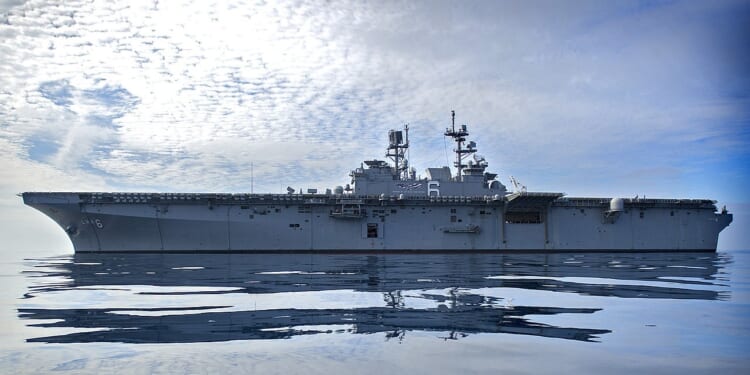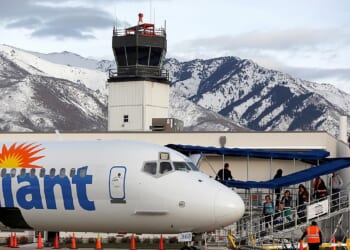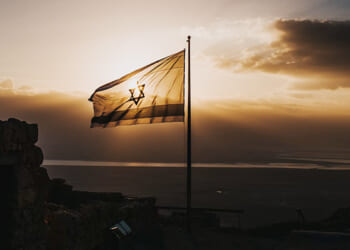The USS America had remained outside the United States since 2019, when it was added to the Forward-Deployed Naval Forces (FDNF) in Japan.
For six years, the United States Navy’s amphibious assault ship USS America (LHA-6) was forward deployed to Sasebo, Japan, operating with the US 7th Fleet and serving as the flagship of Expeditionary Strike Group 7, embarked with the 31st Marine Expeditionary Unit. On Thursday, the ship arrived in her new homeport of Naval Base San Diego, the US Navy announced.
In short, the USS America is back in America.
Earlier this year, it was announced that the USS Tripoli (LHA-7), the second America-class amphibious assault ship, would forward deploy to Sasebo. It was last year that the United States Navy’s Nimitz-class nuclear-powered supercarrier USS George Washington (CVN-73) arrived at the Yokosuka Naval Base, Japan, replacing the USS Ronald Reagan (CVN-76) as the service’s only forward-deployed aircraft carrier.
“I’m incredibly proud of this ship and the hard work and resilience of the entire crew. This year has been packed with operations amidst moving families from Japan to San Diego,” said Capt. Ethan Rule, the ship’s commanding officer. “The demands placed on an FDNF warship are rigorous, and team America has proven time and time again that we are up to the challenge. I couldn’t be more proud of what we’ve accomplished together.”
The USS America Spent Six Years Outside America
LHA-6 arrived in the Land of the Rising Sun in 2019, operating as “key asset with the Forward-Deployed Naval Forces (FDNF),” the US Navy explained. During the six-year mission, the USS America remained a persistent presence in the region, operating alongside allies and partners, including the military forces of Australia, Japan, New Zealand, the Philippines, the Republic of Korea, and Thailand.
It was just this past summer that LHA-6 also carried out joint exercises, including cross-deck operations with the Royal Navy’s flagship HMS Prince of Wales during the British aircraft carrier’s Operation Highmast deployment to the Indo-Pacific.
In early 2020, the USS America was briefly the United States Navy’s most significant operational naval asset in the region, as the USS Theodore Roosevelt (CVN-71) was sidelined in Guam while its crew recovered from COVID-19 at the outset of the global pandemic. Three years later, LHA-6 provided crisis response capabilities, including humanitarian assistance and disaster response (HADR) following the eruption of Mt. Bagana in Papua New Guinea.
This past April, the crew of the America received its fifth consecutive Battle Effectiveness Award (The Battle “E”), which recognized the warship’s ability to demonstrate the excellence and professionalism of its sailors and Marines.
“Serving forward deployed is an incredible challenge and honor,” explained Capt. Michael Plageman, executive officer of America. “Our Sailors and Marines rose to that challenge every single day—demonstrating grit, professionalism, and teamwork in some of the most dynamic waters in the world. As we return to San Diego, we bring with us not only experience but a legacy of operational excellence.”
The USS America Is Not (Technically) an Aircraft Carrier
The USS America could be mistaken for an aircraft carrier. That isn’t surprising, as the warship resembles a smaller version of a full-size US flattop—and, indeed, is larger than the aircraft carriers in the service of many foreign navies. However, LHA-6’s role is different. It is still an aviation-centric platform that projects power by carrying and supporting Marine Expeditionary Units (MEUs) via helicopters and Osprey aircraft.
Lacking the well-deck found in the preceding Wasp-class landing helicopter dock (LHD) amphibious assault ships, USS America was also designed to support air operations centered around the Lockheed Martin F-35B, a fifth-generation multirole aircraft. The short takeoff vertical landing (STOVL) could allow the LHAs to serve as light or “Lightning Carriers,” but critics have warned that the conventionally-powered flat top may lack the same level of survivability as a true supercarrier.
With a Battle “E” for every year of its recent forward deployment, the USS America is clearly a capable warship.
About the Author: Peter Suciu
Peter Suciu has contributed over 3,200 published pieces to more than four dozen magazines and websites over a 30-year career in journalism. He regularly writes about military hardware, firearms history, cybersecurity, politics, and international affairs. Peter is also a contributing writer for Forbes and Clearance Jobs. He is based in Michigan. You can follow him on Twitter: @PeterSuciu. You can email the author: [email protected].
Image: Wikimedia Commons.


















